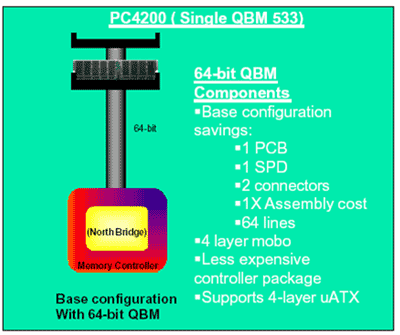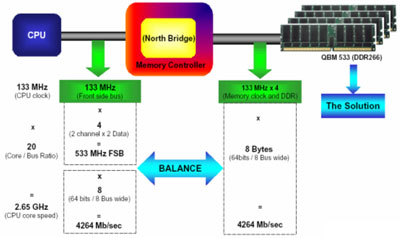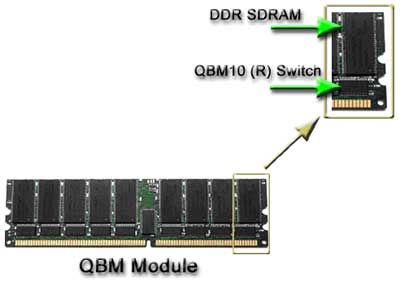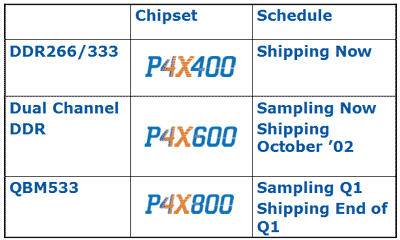
Original Link: https://www.anandtech.com/show/996
VIA Introduces Quad Band Memory - 2X DDR at 1X Prices
by Anand Lal Shimpi on September 17, 2002 1:49 PM EST- Posted in
- CPUs
When RDRAM made its debut on the desktop one of the biggest selling points of the Rambus technology was its very low pincount; at 16-bits per channel compared to the current 64-bit wide DDR buses, it's easy to see where the lower pin count comes from. As a serial interface (much like Serial ATA), lower pin count and the ability to run at very high speeds are major benefits of the technology; not to mention that it is much easier on motherboard manufacturers to design solutions with lower pin count memory interfaces.
Very few can argue that RDRAM did exhibit technical superiority to DDR; however there are issues such as cost, risk and availability of modules that kept the technology out of the mainstream market. Because of this, and the inability of DDR SDRAM to provide as much bandwidth as is necessary for CPUs like the Pentium 4, chipset manufacturers have had to start working on dual channel DDR solutions.
NVIDIA was the first with their 128-bit DDR interface on the original nForce later followed by Intel with their E7500 chipset. Both SiS and VIA will be joining the ranks of dual channel DDR chipset manufacturers but make no mistake, going to dual channel DDR (128-bit parallel memory interface) does not make the life of the motherboard manufacturer any easier.
It isn't impossible to implement a 128-bit memory interface, and you can actually do so on a 4-layer motherboard however that still doesn't mean that motherboard manufacturers wouldn't like to see a simpler solution. DDR-II may end up being that simpler solution, as a single 64-bit wide channel should be able to offer more bandwidth than present day dual channel DDR solutions; the downside is that DDR-II won't be hitting the mainstream market until 2004.
Intel's Prescott CPU will have a 667MHz FSB, demanding a memory interface capable of providing 5.3GB/s of memory bandwidth. While RDRAM definitely fits the bill, the market currently wants a DDR based solution to do the same and unfortunately it would take a dual channel DDR333 solution to provide that sort of bandwidth. It will be done as Springdale (Prescott's intro chipset) will be a dual channel DDR333 platform, but again, the motherboard manufacturers want something simpler.
Being very in touch with the motherboard manufacturers and desperately trying to drum up interest in their Pentium 4 chipsets, VIA announced an alternative memory architecture based on currently available DDR technology: Quad Band Memory (QBM).
The QBM Chipset Architecture
A chipset that supports Quad Band Memory (QBM) simply implements a conventional 64-bit DDR SDRAM memory interface with support in the memory controller for QBM modules. The obvious benefit of this is that the layout is no more complicated than any other motherboard with a single channel DDR interface, music to the ears of motherboard manufacturers. The bus interfaces to the same 184-pin DDR SDRAM slots we've been seeing on boards for years now.

Instead of putting the burden on motherboard manufactures to implement a dual channel DDR memory bus, the burden is placed on the memory manufacturers to produce special QBM modules. We'll get to exactly how these modules are made in a minute, but first let's talk about one of the benefits of the QBM chipset design.

Because of the pin-compatible DDR interface, QBM chipsets will be able to use both regular DDR SDRAM modules as well as QBM modules. Obviously regular DDR modules will offer lesser amounts of memory bandwidth but the backwards compatibility means that motherboard manufacturers would be able to produce one board for multiple segments (single channel DDR for mainstream and QBM for high end).
But what exactly do QBM modules do and how do they offer more memory bandwidth over the same 64-bit bus as DDR SDRAM? The explanation is actually quite simple…
QBM: How it works
A QBM module starts off just like a regular DDR SDRAM module but with a minimum of 16 DDR SDRAM devices on the module itself. Eight of these devices belong to the first bank, and the other eight belong to the second bank - one on each side of the DIMM. What we've just described is identical to a double sided DDR SDRAM DIMM with 16 chips. As we've mentioned before, a QBM module still has the same 184-pin interface as a conventional DDR DIMM.

Here's where the difference between QBM and conventional modules comes into play; QBM modules will have a set of 8 registers (QBM-10) as well as a phase-locked loop (PLL). The purpose of the PLL is to take the incoming clock signal from the chipset and shift it by 90 degrees; this shifted signal is then fed to the second bank of the DIMM, while the first bank receives the unaltered clock directly from the chipset.
The 8 registers then switch between which bank gets to transfer data every clock; because of the 90 degree phase shift, there is a slight delay in transferring data from the second bank but both transfers actually end up happening within a single clock cycle. The end result is that you get two DDR transfers per clock, or 4 bits of data are sampled per clock thus doubling the throughput of DDR (hence the name Quad Band Memory).
|
Memory
Bandwidth Comparison
|
|||
| Memory Type |
Bandwidth
|
||
| DDR266 |
2.1GB/s
|
||
| DDR333 |
2.7GB/s
|
||
| Dual Channel DDR266 |
4.2GB/s
|
||
| Dual Channel DDR333 |
5.3GB/s
|
||
| QBM533 |
4.2GB/s
|
||
| QBM667 |
5.3GB/s
|
||
Final Words: Thinking about QBM
VIA's first chipset to support QBM will be the P4X800 for the Pentium 4; the chipset will begin sampling in Q1-2003 and it will ship by the end of Q1-2003. Unfortunately this in itself may limit the success QBM sees; we've already established that motherboard makers won't touch VIA's renegade Pentium 4 chipset because of pressure from Intel, and even though QBM is a tempting technology we have our doubts that it will be what causes players like ASUS and MSI to go against Intel's wishes. The QBM technology itself is licensed from Kentron Technologies, so in theory SiS could obtain a license to produce their own QBM enabled chipsets should the technology take off.

The obvious benefits of QBM are very low cost of (motherboard) implementation and instant doubling of memory bandwidth. Unfortunately VIA is at the mercy of the memory manufacturers when it comes to getting QBM off the ground; both Elpida and Infineon have signed on as providers but it's going to take more than that for QBM to gain mainstream success (the support of two manufacturers is exactly what RDRAM had remember?). QBM modules will obviously be more expensive than regular DDR modules, the question of how much remains to be answered however.
The technology is interesting but as is often the case, it's going to take more than neat technology to get QBM off the ground. With SiS making heavy gains in the Pentium 4 chipset market, VIA needs to do all it can to regain some of that Intel platform market share it lost when the Pentium III was phased out.







